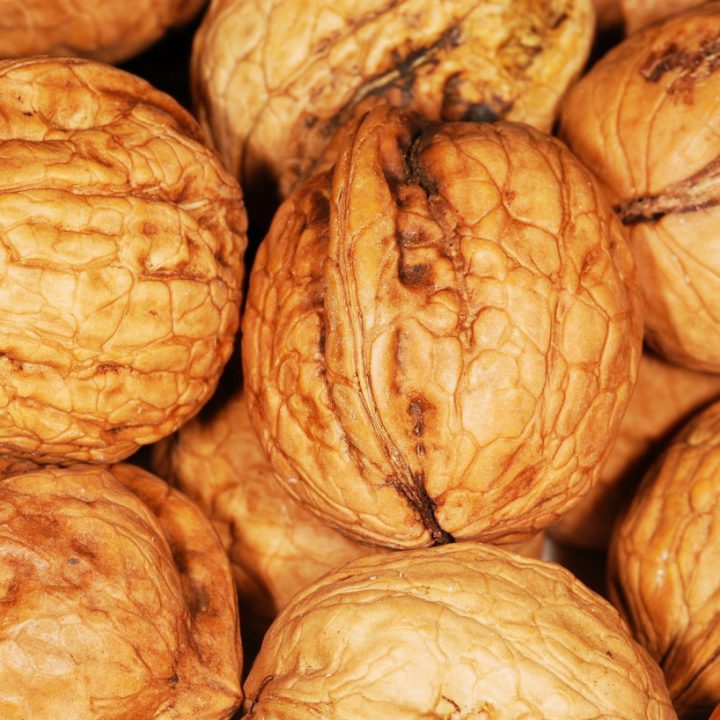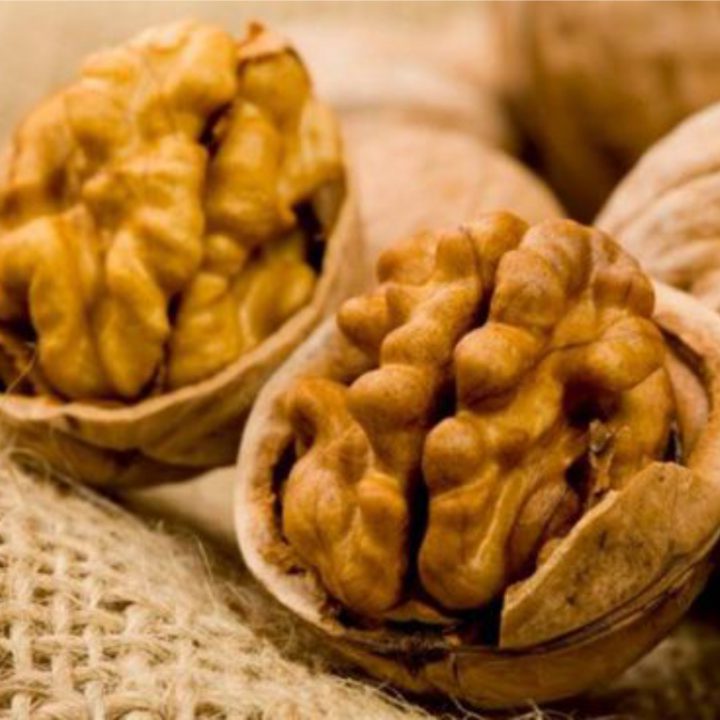Copyright © 2022 Global Sky Business. All Rights Reserved.

Worldwide Walnuts Production
Global walnut production and exports will break a record during 2020/21, which will impact the US market as it relies heavily on exports. Although US production has reached new levels, it is likely to remain in check due to a lack of price incentives. The report below provides production and price estimates for the next five years.
World production of walnuts will reach almost 2.3 million tons (in shell) during the 2020/21 campaign. That level of production represents an increase of 7% year-on-year and about 5% growth compared to the previous production record in 2016/17.
More than 80% of the 2020/21 world walnut production will come from three countries: China, the United States and Chile, with shares of 45%, 31% and 7%, respectively. Other walnut producers include the EU, Ukraine, Turkey, India and Australia.
Production from the US and Chile is expected to grow around 20% year-on-year, setting new records, while China’s production has recovered after a 15% drop in 2018/19. The increase in world production will create greater international competition in the export market.
World walnut exports are forecast to grow around 14% yoy during 2020/21, with exports from the United States expected to rise around 18% yoy and those from Chile about 25% yoy. The United States and Chile have been the largest exporters of walnuts in recent years. But the rapid growth of exports from China, which is quickly capturing market share, has hurt the market and has surprised some analysts. China is now vying for second place as a walnut exporting country.

Global Walnuts Production & Exports
According to preliminary estimates, the exports of walnuts from China increased by 60% in value terms in 2021, despite record low walnut prices in the first half of the year. Notably, several post-Soviet states are among the main importers.
China has set new records for the exports of inshell walnuts and walnut kernels in 2021. According to our estimates, the exports of kernels has doubled over the year to 45-47 thousand tonnes, and the exports of inshell walnuts has increased by 50% to 110-115 thousand tonnes.
In total, China earned about $420 million from the exports of walnuts in 2021, which was also a new record. Thus, China may rank third among walnut exporters in 2021, bypassing Chile and increasing the gap with Ukraine, which still remains the fifth. Ukraine continued to experience difficulties with walnut exports due to low global prices and changes in the regime of access to the Turkish market (read more about the results of the Ukrainian walnut season here).


It should be noted that there are three post-Soviet countries among the six largest buyers of Chinese walnuts: Kazakhstan, Kyrgyzstan and Russia. At the same time, the exports of walnuts from China to Russia in 2021 increased by more than 50%.
Unexpectedly, the UAE became the main buyer of walnuts in 2021, having increased imports by 250%. Kazakhstan and Kyrgyzstan are the second and third, respectively.
Turkey, which sharply reduced the imports of walnuts from Ukraine, seems to have replaced Ukrainian walnuts with Chinese ones. The exports of walnuts from China to Turkey increased around 120% by the end of 2021, and Turkey ranked fourth among the most important walnut markets for China.
We also note three more fastest growing markets for Chinese nuts: Iraq, Vietnam and Saudi Arabia. These countries have more than doubled their imports of Chinese walnuts in a year.
The Importance of Chilean Walnuts in the International Market
Chile is the second largest exporter of walnuts worldwide and the third largest producer, and today the walnut is probably the number one fruit in the country with the largest planted area in Chile with more than 46 thousand hectares.
“All the big buyers in Europe have Chile as part of their purchase campaign for the second half of 2022”
The harvest of the new walnut season has already begun in Chile, the largest player in this industry in the entire southern hemisphere, in a campaign that starts with good prospects.
“The 2020 and 2021 seasons, in which there has been a growing demand for dried fruit, especially walnuts. Much of the increase in Chilean dried fruit sales is attributable to the pandemic, as consumers opted for a diet healthier and more accessible”
World's Largest Producers of Walnuts Kernel Basis
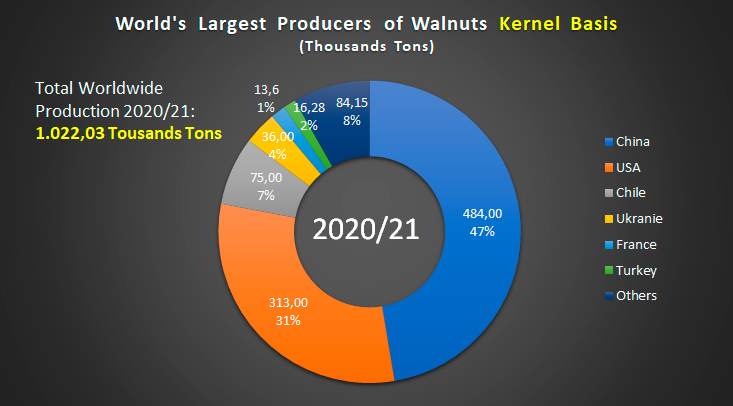
“All of Chile’s growth has been developed hand in hand with the mechanical game, which obviously requires greater technology both in the game and in electronic selection, and little by little Chilean producers and exporters have been positioning the product above all in the market. European. For Chile, Europe is the main target destination, where there is also a tariff preference with respect to the United States of 5.1% and Chile also has the advantage of having an off-season product”.
“Little by little, Chile has been advancing in the European market in such a way that today all the major buyers on the continent have Chile as part of their second-half purchase campaign; they are supplied from the United States from October to April, and from May to December, which includes a large part of the Christmas campaign, they are already formally and planned supplying from Chile”
World's Largest Producers of Walnuts In-Shell Basis
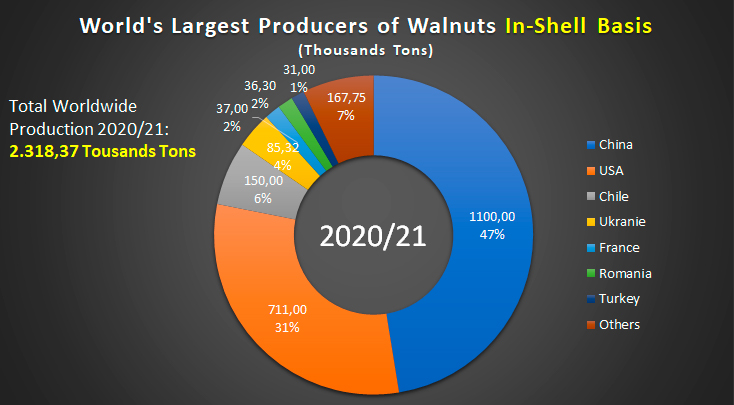
China’s shelled walnut exports rise
“As for walnuts in the shell, last year’s campaign was more complex. The shell business is developed in other countries, mainly in Turkey and Morocco, and last year China flooded those markets.”
“China is the main producer of walnuts in the world, it produces almost a million tons, but in the international context it practically did not export. However, in 2020 it increased its shipments to 123,000 tons and in 2021 to 215,000. The shell market is a little more difficult, but not so for the party; I see it with a fairly strong demand in our main market, the European Union, and that for Chile is very important”.
World's Largest Exporters of Walnuts Kernel Basis

Chilean Evolution Walnut Production & Forecast Until 2030

Walnuts Review
The walnut is the fruit of the walnut tree, and belongs to the Juglandaceae family. Its tree grows in all temperate climates of the world. It is a fruit with a hard, woody shell, which, when cut in half, presents a dry yellowish-brown pulp in the shape of a brain. There are more than fifteen varieties of this family, but the most appreciated is the Juglans regia, called Persian or English walnut. Other well known varieties are: European walnut (Juglans cinerea), black walnut (Juglans nigra) and California walnut (Juglans californica).
Known and consumed since prehistoric times, its origin has not been defined exactly, it is believed that Persia (Iran) and the Caucasus is its homeland. The Greeks called it kara (head) because of its resemblance to the human brain. The Romans considered it the food of the gods, while all the ancients agreed to associate walnuts with health and a good memory..
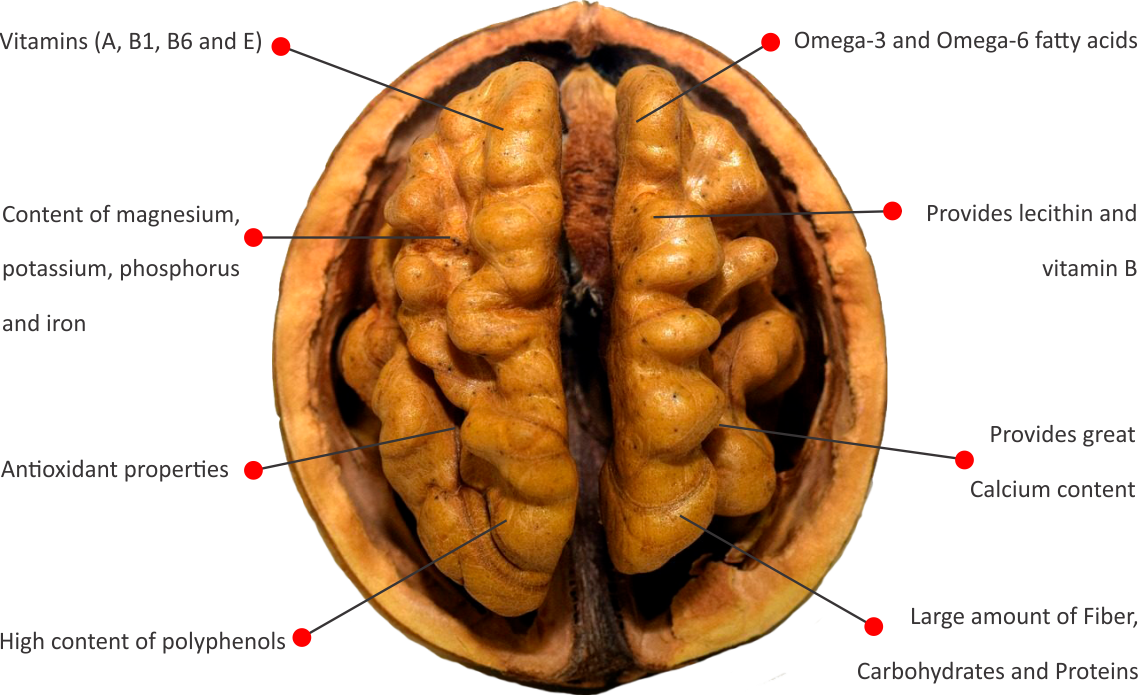
Nutritional assessment
Polyunsaturated fatty acids, unsaturated fatty acids, omega 3 fatty acids, fiber, iron, zinc, potassium, selenium, phosphorus, magnesium, thiamin, niacin, folate, and vitamin B6.
The walnut is a very energetic dried fruit with a high percentage of fat in its composition. Of it, saturated fatty acids (SFA) are equivalent to 11% of the total, monounsaturated fatty acids (AGM) to 16%, and polyunsaturated fatty acids (AGP) to 68%. The good balance in the supply of essential fatty acids, and the significant contribution of polyunsaturated and monounsaturated fats, improves the lipid profile.
Walnuts are a source of fiber and contain up to 14% protein. However, proteins are deficient in an essential amino acid, methionine, so combining them with cereals (nut bread), a quality protein similar to animal protein is obtained. On the other hand, this protein has a significant content of arginine.
It is also an important source of omega 3 fatty acids. The nut is a source of iron, zinc, potassium, selenium, phosphorus and magnesium. Regarding minerals, a walnut serving provides 10% of the recommended phosphorus intake for the study population.
It is also a source of vitamins B1, B3 (niacin) and especially folate and vitamin B6. The latter contributes to the normal formation of red blood cells.
[2020/21]
Chilean Campaign
[46.000 ha]
planted area
[150.000 Tn]
Production
[81.613 Tn]
Inshell Exports
[30.940 Tn]
Shelled Exports
AVAILABILITY:
Immediate
DELIVERY TERM:
45 days
INCOTERMS:
FOB / CIF
PRODUCT ORIGIN:
Brazil
BUYER'S DOCUMENTS:
LOI & RWA
PAYMENT TERMS:
30% Advanced TT. 70% Remaining, L/C against Shipping Documents

We offer a complete range of commodities originating in South America.
Contacts
- Brazil: Av. Santos Dumont N°1883, Floor 5th, office 532/533, Aero Empresarial Building, Lauro de Freitas, Bahia, Brazil.
- Argentine: Tucuman 1946, Office N°04 - Córdoba, Argentina.
- info@globalskybusiness.com
- +55 71 98205 1492
Main Commodities
Subscribe
Follow our newsletter to stay updated about agency.






